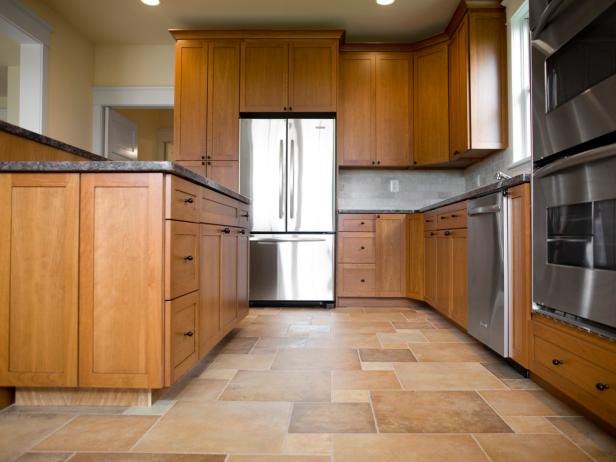If you're looking at classic floor tile for your kitchen, you won't be disappointed.

Tile flooring is a natural choice for kitchens. Tile is hard, durable, water-resistant and shrugs off stains. Plus, it’s beautiful—your kitchen flooring ideas will blossom when you look through the huge array of styles, shapes and colors available.
Kitchen floor tile comes in three types: porcelain, ceramic and stone. Prices of each type run the gamut, from $2 to $100 per square foot.
Types of Kitchen Tile Flooring
Ceramic and porcelain tile are similar. Both are made from clay mixtures fired at high temperatures to produce a hard, durable tile. Both come either glazed or unglazed. Beyond that, there are important differences.
Porcelain floor tile has sand added to the clay mixture and is made with heat and pressure to produce a tile that’s harder, denser and less porous than regular ceramic tile. It’s a good choice for high-traffic areas, kitchens and bathrooms. It’s tough enough to be used outdoors in any climate.
Glazed porcelain tile has a glass-like coating applied during firing to produce colored surface. Unglazed porcelain has color added to the clay mixture so the color and pattern is carried all the way through the tile. Any wear or scratches won’t show on unglazed porcelain.
Porcelain can be difficult to install and requires special tools, making installation a less DIY-friendly project.
Regular ceramic floor tile is sometimes called “non-porcelain” to clearly differentiate it from porcelain. It’s softer than its porcelain cousin and glazed to create a hard wear surface in virtually any color. Because it’s softer, it’s easier to cut and install. Although it’s more porous than porcelain, the glazing creates a surface that’s impervious to kitchen spills and splashes.
Stone floor tiles are made from natural stone including slate, granite, limestone, travertine, and marble. Most stone tiles are porous and need to be refinished with a quality stone sealer every two to three years.
Stone can be polished or honed. Polished stone surfaces are slippery when wet, but the polishing lets the full beauty of the stone show through. Honed stone tiles provide more traction but have a less vibrant look.
Drawbacks of Kitchen Tile Flooring
Tile is a hard, unforgiving surface. Dropped glasses and dishes won’t survive, and long hours of food prep may bring about fatigue. Tile reflects sound, so tile flooring can contribute to a noisy environment. Area rugs and anti-fatigue mats are good remedies.
Tile requires maintenance, too. Although ceramic tile itself is durable, the grout between tiles can get dingy with age. Use a grout sealer on a regular basis to keep your floors looking new.
Tiles surfaces can be slippery when wet. If you’re concerned about traction, look for tiles that are certified to be slip-resistant by the Americans with Disabilities Act. You should be able to spot the ADA certification on packing boxes and product literature.
